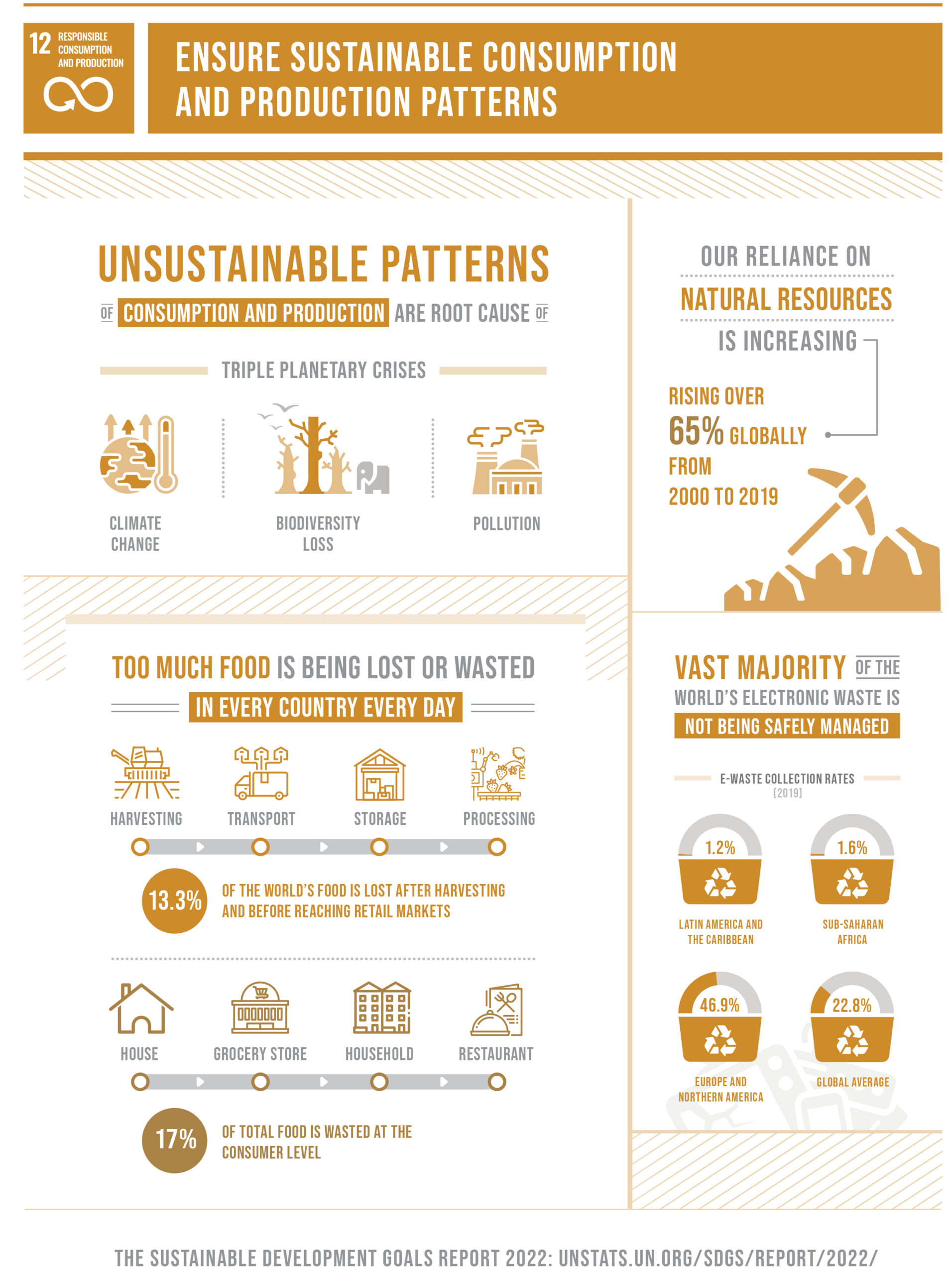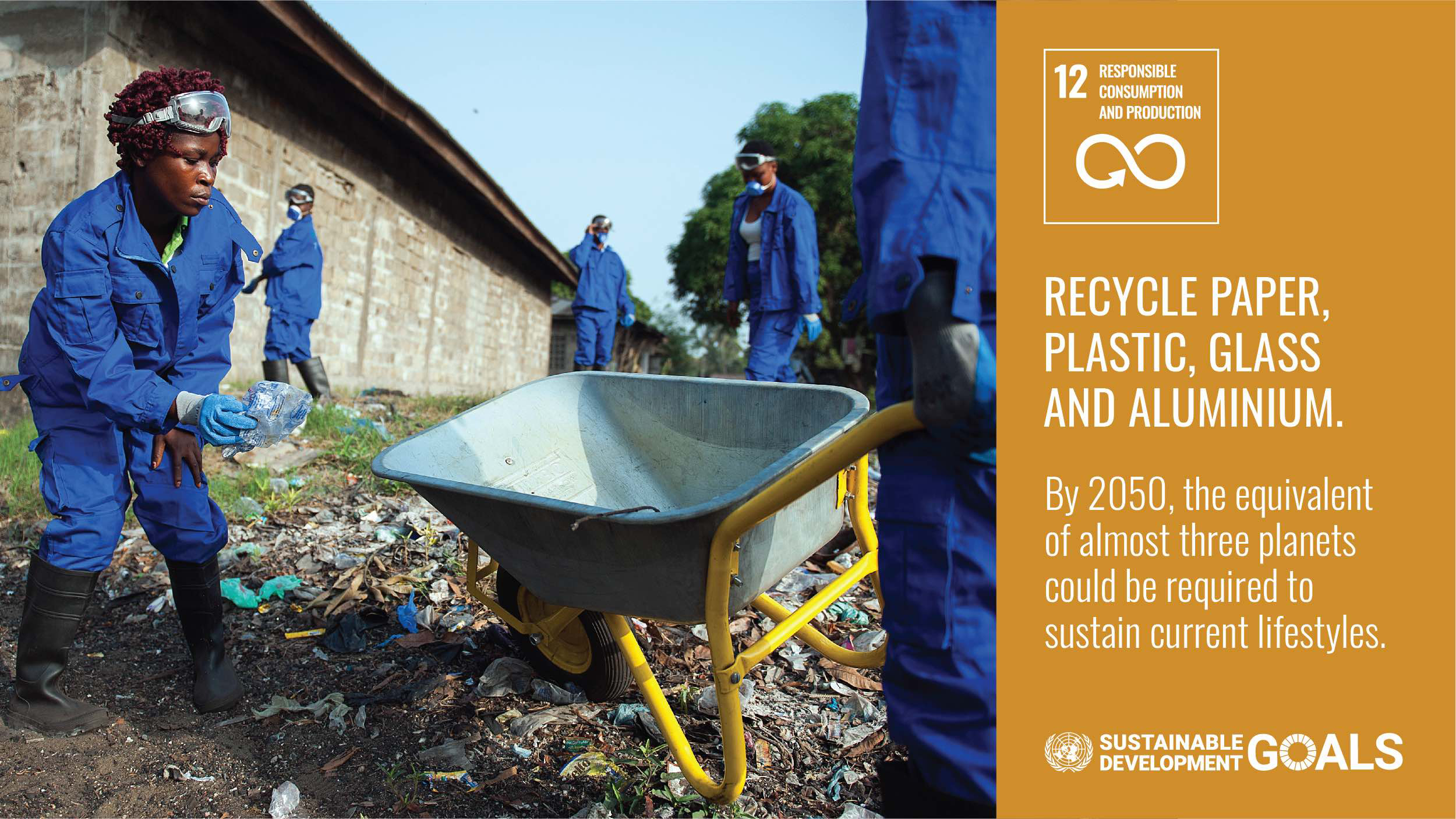Sustainable Consumption
Worldwide consumption and production — a driving force of the global economy — rest on the use of the natural environment and resources in a way that continues to have destructive impacts on the planet.
Economic and social progress over the last century has been accompanied by environmental degradation that is endangering the very systems on which our future development — indeed, our very survival — depends.
A few facts and figures:
- Each year, an estimated one third of all food produced – equivalent to 1.3 billion tonnes worth around $1 trillion – ends up rotting in the bins of consumers and retailers, or spoiling due to poor transportation and harvesting practices.
- If people worldwide switched to energy efficient light bulbs the world would save US$120 billion annually.
- Should the global population reach 9.6 billion by 2050, the equivalent of almost three planets could be required to provide the natural resources needed to sustain current lifestyles.
The COVID-19 pandemic offers countries an opportunity to build recovery plans that will reverse current trends and change our consumption and production patterns towards a more sustainable future.
Sustainable consumption and production is about doing more and better with less. It is also about decoupling economic growth from environmental degradation, increasing resource efficiency and promoting sustainable lifestyles.
Sustainable consumption and production can also contribute substantially to poverty alleviation and the transition towards low-carbon and green economies.
Sustainable Development Goals
The 2030 Agenda for Sustainable Development was adopted by all United Nations Member states in 2015, an agenda that provides a shared blueprint for peace and prosperity for people and the planet, now and into the future.
The 17 Sustainable Development Goals (SDGs) are an urgent call for action by all countries – developed and developing – in a global partnership. They recognize that ending poverty and other deprivations must go hand-in-hand with strategies that improve health and quality education, reduce inequality, and spur economic growth – all while tackling climate change and working to preserve our oceans and forests. Learn more about the UN SDG’s.

What is the goal here?
To ensure sustainable consumption and production patterns.
Why?
Economic and social progress over the last century has been accompanied by environmental degradation that is endangering the very systems on which our future development and very survival depend.
COVID-19 offers an opportunity to develop recovery plans that will reverse current trends and shift our consumption and production patterns to a more sustainable course. A successful transition will mean improvements in resource efficiency, consideration of the entire life cycle of economic activities, and active engagement in multilateral environmental agreements.
What needs to change?
There are many aspects of consumption that with simple changes can have a big impact on society as a whole. For example, the global material footprint – an indicator of the pressure put on the environment to support economic growth and to satisfy the material needs of people – grew by 17.4 per cent to 85.9 billion metric tons in 2017 as compared to 2010.
Reducing food loss and waste can contribute to environmental sustainability by lowering production costs and increasing the efficiency of food systems. Currently, we lose 13.8 per cent after harvesting and during transport, storage and processing alone, amounting to a cost of over $400 billion a year. We are also polluting water faster than nature can recycle and purify water in rivers and lakes.
How can I help as a business?
It’s in businesses’ interest to find new solutions that enable sustainable consumption and production patterns. A better understanding of environmental and social impacts of products and services is needed, both of product life cycles and how these are affected by use within lifestyles. Identifying “hot spots” within the value chain where interventions have the greatest potential to improve the environmental and social impact of the system as a whole is a crucial first step. Innovation and design solutions can both enable and inspire individuals to lead more sustainable lifestyles, reducing impacts and improving well-being.
How can I help as a consumer?
There are two main ways to help: 1. Reducing your waste and 2. Being thoughtful about what you buy and choosing a sustainable option whenever possible. Ensure you don’t throw away food, and reduce your consumption of plastic—one of the main pollutants of the ocean. Carrying a reusable bag, refusing to use plastic straws, and recycling plastic bottles are good ways to do your part every day.
Making informed purchases also helps. For example, the textile industry today is the second largest polluter of clean water after agriculture, and many fashion companies exploit textile workers in the developing world. If you can buy from sustainable and local sources you can make a difference as well as exercising pressure on businesses to adopt sustainable practices.

Facts and Figures
- According to latest projections, the global population could grow to around 8.5 billion in 2030, 9.7 billion in 2050. The equivalent of almost three planets could be required to provide the natural resources needed to sustain current lifestyles.
- 93 per cent of the world’s 250 largest companies are now reporting on sustainability.
Water
- Less than 3 per cent of the world’s water is fresh (drinkable), of which 2.5 per cent is frozen in the Antarctica, Arctic and glaciers. Humanity must therefore rely on 0.5 per cent for all of man’s ecosystem’s and freshwater needs.
- Humankind is polluting water in rivers and lakes faster than nature can recycle and purify
- More than 1 billion people still do not have access to fresh water.
- Excessive use of water contributes to the global water stress.
- Water is free from nature, but the infrastructure needed to deliver it is expensive.
- Water use has been increasing worldwide by about 1per cent per year since the 1980s.
- Agriculture (including irrigation, livestock and aquaculture) is by far the largest water consumer, accounting for 69per cent of annual water withdrawals globally. Industry (including power generation) accounts for 19per cent and households for 12per cent.
- Over 2 billion people live in countries experiencing high water stress.
- Over the period 1995–2015, floods accounted for 43per cent of all documented natural disasters, affecting 2.3 billion people, killing 157,000 more and causing US$662 billion in damage.
- Three out of ten people (2.1 billion people, or 29per cent of the global population) did not use a safely managed drinking water service4 in 2015, whereas 844 million people still lacked even a basic drinking water service.
Energy
- If people worldwide switched to energy efficient lightbulbs, the world would save US$120 billion annually.
- Despite technological advances that have promoted energy efficiency gains, energy use in OECD countries will continue to grow another 35 per cent by 2020. Commercial and residential energy use is the second most rapidly growing area of global energy use after transport.
- In 2002 the motor vehicle stock in OECD countries was 550 million vehicles (75 per cent of which were personal cars). A 32 per cent increase in vehicle ownership is expected by 2020. At the same time, motor vehicle kilometers are projected to increase by 40 per cent and global air travel is projected to triple in the same period.
- Households consume 29 per cent of global energy and consequently contribute to 21 per cent of resultant CO2 emissions.
- The share of renewable energy in final energy consumption has reached 17.5per cent in 2015.
- The global electrification rate reached 89per cent in 2017 (from 83per cent in 2010), still leaving about 840 million people without access
- Between 2010 and 2017, the percentage of the population relying on clean cooking solutions grew by an annual average of 0.5 percentage points.
- The global population without access to electricity fell from 1.2 billion in 2010 to 840 million in 2017.
Food
- Each year, an estimated 1/3 of all food produced – equivalent to 1.3 billion tons worth around $1 trillion – ends up rotting in the bins of consumers and retailers, or spoiling due to poor transportation and harvesting practices
- 38 million children under the age of 5 were overweight or obese in 2019.
- Land degradation, declining soil fertility, unsustainable water use, overfishing and marine environment degradation are all lessening the ability of the natural resource base to supply food.
- The food sector accounts for around 30 per cent of the world’s total energy consumption and accounts for around 22 per cent of total Greenhouse Gas emissions.
Goal 12 targets
- 12.1 Implement the 10-year framework of programmes on sustainable consumption and production, all countries taking action, with developed countries taking the lead, taking into account the development and capabilities of developing countries
- 12.2 By 2030, achieve the sustainable management and efficient use of natural resources
- 12.3 By 2030, halve per capita global food waste at the retail and consumer levels and reduce food losses along production and supply chains, including post-harvest losses
- 12.4 By 2020, achieve the environmentally sound management of chemicals and all wastes throughout their life cycle, in accordance with agreed international frameworks, and significantly reduce their release to air, water and soil in order to minimize their adverse impacts on human health and the environment
- 12.5 By 2030, substantially reduce waste generation through prevention, reduction, recycling and reuse
- 12.6 Encourage companies, especially large and transnational companies, to adopt sustainable practices and to integrate sustainability information into their reporting cycle
- 12.7 Promote public procurement practices that are sustainable, in accordance with national policies and priorities
- 12.8 By 2030, ensure that people everywhere have the relevant information and awareness for sustainable development and lifestyles in harmony with nature
- 12.A Support developing countries to strengthen their scientific and technological capacity to move towards more sustainable patterns of consumption and production
- 12.B Develop and implement tools to monitor sustainable development impacts for sustainable tourism that creates jobs and promotes local culture and products
- 12.C Rationalize inefficient fossil-fuel subsidies that encourage wasteful consumption by removing market distortions, in accordance with national circumstances, including by restructuring taxation and phasing out those harmful subsidies, where they exist, to reflect their environmental impacts, taking fully into account the specific needs and conditions of developing countries and minimizing the possible adverse impacts on their development in a manner that protects the poor and the affected communities
Links:
The 10-Year Framework of Programmes on Sustainable Consumption and Production
UN Environment Programme – Resource efficiency
FAO website for Sustainable Production
International Telecommunications Union
UNDP page for Sustainable Production & Consumption

We, at AI for Good foundation, are using AI + ML initiatives in pursuit of the 17 SDGs. With various projects in progress, such as our Climate Trend Scanner and the SDG Data Catalog, we are determined to help and facilitate achieving the goals.







